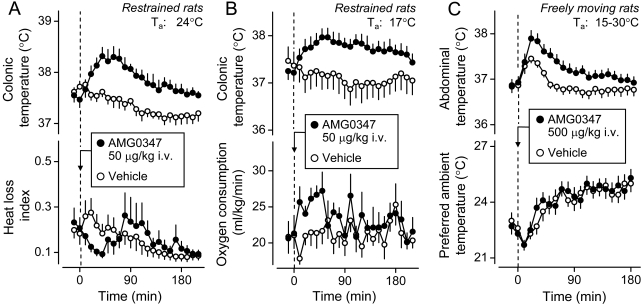Fig. 7.
Recruitment of autonomic, but not behavioral, thermoeffectors in the hyperthermic response of rats to AMG0347. AMG0347 (50 μg/kg i.v.) was administered to loosely restrained rats either at a low neutral Ta of 24°C (A) or at a subneutral Ta of 17°C (B). In either case, the injections were performed through a preimplanted jugular catheter, from outside the environmental chamber, without disturbing the animals (Steiner et al., 2007). Because the procedure of drug administration did not cause stress, injection of a vehicle alone did not affect colonic temperature. At 24°C, the hyperthermic response to AMG0347 occurred, at least in part, because of tail skin vasoconstriction (a decrease in the HLI). At 17°C, the hyperthermic response to AMG0347 occurred, at least in part, because of thermogenesis activation (an increase in oxygen consumption). AMG0347 (500 μg/kg i.v.) also caused hyperthermia in a thermogradient apparatus (C). In this setup, the procedure for drug administration involved handling, and the injection of vehicle caused stress hyperthermia, but the hyperthermic response to AMG0347 was higher and lasted longer than the response to the vehicle. Even though a high dose of AMG0347 was used in this experiment, thermoregulatory behavior was not recruited, and the drug-injected rats preferred the same Ta as the rats injected with the vehicle. [Modified from Steiner AA, Turek VF, Almeida MC, Burmeister JJ, Oliveira DL, Roberts JL, Bannon AW, Norman MH, Louis JC, Treanor JJ, et al. (2007) Nonthermal activation of transient receptor potential vanilloid-1 channels in abdominal viscera tonically inhibits autonomic cold-defense effectors. J Neurosci 27:7459–7468. Copyright © 2007 Society for Neuroscience. Used with permission.].

